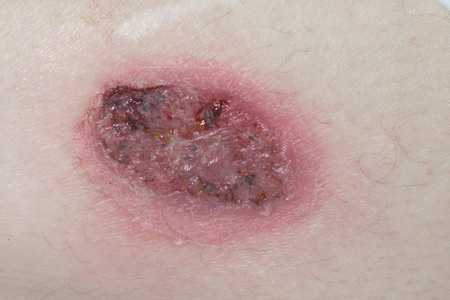History and exam
Key diagnostic factors
common
recreational or occupational exposures
primary residence in or travel to endemic areas
Other diagnostic factors
common
male sex
Males outnumber females from 4:1 to 15:1.[23]
constitutional symptoms
Fever, weight loss, or fatigue may occur.
cough
Cough with purulent sputum is a common complaint in pulmonary disease caused by Blastomycosis. However, asymptomatic pulmonary involvement is frequently diagnosed by chest x-ray, and disseminated disease spread haematogenously may be the first clinical clue to disease.
skin lesions
Skin lesions are usually chronic and can appear nodular, ulcerated, or verrucous. Typically have a raised irregular border. Skin lesions are the second most common manifestation of blastomycosis. [Figure caption and citation for the preceding image starts]: Cutaneous blastomycosis on the forearmPersonal files of Larry Baddour, MD [Citation ends]. [Figure caption and citation for the preceding image starts]: Cutaneous blastomycosis on the lower extremityLuAnn Ziemer, Office of Medical Photography, Mayo Clinic, Rochester, MN [Citation ends].
[Figure caption and citation for the preceding image starts]: Cutaneous blastomycosis on the lower extremityLuAnn Ziemer, Office of Medical Photography, Mayo Clinic, Rochester, MN [Citation ends]. [Figure caption and citation for the preceding image starts]: Cutaneous blastomycosis on the lower extremityLuAnn Ziemer, Office of Medical Photography, Mayo Clinic, Rochester, MN [Citation ends].
[Figure caption and citation for the preceding image starts]: Cutaneous blastomycosis on the lower extremityLuAnn Ziemer, Office of Medical Photography, Mayo Clinic, Rochester, MN [Citation ends]. [Figure caption and citation for the preceding image starts]: Cutaneous manifestation of disseminated blastomycosisPersonal files of Larry Baddour, MD [Citation ends].
[Figure caption and citation for the preceding image starts]: Cutaneous manifestation of disseminated blastomycosisPersonal files of Larry Baddour, MD [Citation ends].
uncommon
animal exposure
A previous or co-incident infection in a pet dog is a clue to environmental exposure of the fungus rather than a mode of transmission.
bone or joint pain
Bone or joint pain may be a clue to osteoarticular involvement with blastomycosis.
Presentation most frequently mimics a monoarticular, septic arthritis.
genitourinary symptoms
In men, blastomycosis can present with prostatitis, epididymo-orchitis, or infection of other genitourinary (GU) sites. Women can develop tubo-ovarian abscesses, endometritis and salpingitis.[5]
Always a manifestation of disseminated disease, but not all people with disseminated disease have GU involvement.
headache or focal neurological complaints
Central nervous system involvement occurs in 5% to 10% of cases of blastomycosis and can manifest as meningitis or as a space-occupying lesion.[23]
Risk factors
strong
recreational or occupational exposures
Important exposures include to waterways with beaver dams or ponds, wooded areas, or river banks with rotting vegetation.[15][16]
One study using a lymphocyte stimulation assay found that 30% of forestry workers in Northern Minnesota and Wisconsin had been exposed to Blastomyces dermatitidis in the past.[25] Direct inoculation of the skin has occurred with various types of outdoor and occupational activities.[24]
travel to or residence in an area of endemicity
Although occasional sporadic cases have a worldwide distribution, areas of high endemic rates include the Midwestern, South Central and Southeastern US along the Mississippi river valley, Canada, and South Africa.[13][14][17][18][26][27][28] Data also suggest that blastomycosis may be endemic in the Northeastern region of the US.[11][12]
weak
male sex
Cases in men typically outnumber those in women, with a ratio between 4:1 and 15:1 depending on the series. However, this is generally thought to be secondary to increased environmental exposure in men as opposed to an actual sex predilection.[15]
immunocompromise
Blastomycosis does not appear to be more common in people who are immunocompromised. However, infection in a compromised host is more frequently complicated with adult respiratory distress syndrome or extrapulmonary dissemination.[29]
Very few patients with HIV/AIDS develop disseminated disease. This is because neutrophils are important for the host defence of blastomycosis, and patients with HIV/AIDS generally have T-cell defects but intact neutrophil function.
Use of this content is subject to our disclaimer